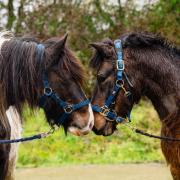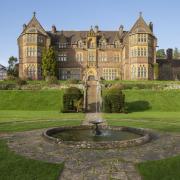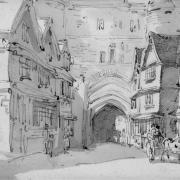The group of nine and ten-year-olds sat around the tables in the converted barn at East Shallowford Farm this morning have already been very busy. Since they arrived earlier this week from their school in Bristol, the Year Fives have mucked out the pigs, fed the cows, met Rodney the bull and climbed to the top of the nearest tor in the pouring rain.
Today, the children are starting their day with an interactive lesson on Dartmoor’s farming history and how their food is produced, led by Shallowford Farm Trust manager Julia McDade.

The kids have done really well. For atleast half-an-hour or so, everyone has been listening intently and giving great answers to questions about where food comes from and why this landscape is so important. But chairs are starting to scrape the floor and everyone is getting a bit fidgety.
Sensing this, Julia disappears for a few minutes and walks back into the room, her hands cupped together. ‘Ssssssshhhhhh!’ she says. ‘Can you hear something?’ In the sudden silence, you can just about make out the chirping noises of a newly hatched chick.

The room lets out a collective gasp and each child takes it in turn to have a look at this tiny new life. ‘It’s about bringing it all back to the basic elements,’ says Julia afterwards. ‘We teach the kids thatthe animals always come first and that they have a responsibility to work together and look after them.’
East Shallowford Farm, run by the Shallowford Trust, has been doing this kind of thing for more than 40 years. The site near Widecombe-in-the-Moor was boughtin 1976 by Elizabeth Braund and her friend Rosemary Bird. The pair, both awarded the MBE, were devoted to improving the lives of inner-city youngsters, setting up Providence House youth centre in Battersea, south London in 1963. When they bought their Dartmoor hill farm, Elizabeth and Rosemary started organising regular trips to their ‘lung for the city’. Here, children and teens who had never set foot in the countryside before stayed for a week and were taught to experience the joys and challenges of caring for animals, while developing their sense of community and self-worth in the process.

Elizabeth Braund died in 2013 and Rosemary Bird died in 2010 but their legacy here at East Shallowford lives on. Today, we sit around chatting while the kids are finding waterproofs and wellies, ready to go foraging.
‘The most rewarding element for me is seeing the kids’ confidence and self-esteem grow,’ says David Onah, programme officer. ‘A lot of the children we have are very nervous when they get here. They also ask things like, “Is there a KFC nearby?” Some shy away in a corner and spend the whole time in silence at first.’

It’s never too long, however, before even the most reluctant farmers get their hands dirty. David, Julia and conservation officer Ellie Baker are full of uplifting tales of quiet, shy kids – some who have had the toughest of starts in life – getting down to the business of feeding and mucking out, seed collecting, planting, helping with meals, collecting eggs – all the jobs that make a working farm work.
Time is also set aside to be proper countryside kids, rolling down hills and playing in the mud etc.
‘I had a group out with me the other day who just started rolling in a puddle,’ says Ellie. ‘They told me they weren’t normally allowed to get dirty and they were having such a good time,’ she adds, explaining that activities can occasionally go off-piste and the best thing to do is go with the flow. ‘Sometimes things like that just happen and you think to yourself, ok, we’ll stick with that for a while…!’ Julia tells me about another occasion when the resident boar refused to leave the barn.
One teenage girl – who’d hardly said a thing all week – took it upon herself to sort the situation out. ‘This girl,’ says Julia. ‘She was not a leader, but her classmates were stood around wondering what to do and she said, “Oh, for goodness’ sake!” She pushed through all of the other kids and managed to get the boar into the field. The others all gave her a huge round of applause afterwards. It was lovely.’

Shallowford Farm has developed over the years as demand for the back-to-basics service it provides has risen. Hundreds of school children visit every year from London, Bristol, and from areas of Devon, such as Plymouth and Torbay. School visits are usually a week long, while youth and adult community groups, plus organisations such as the Dartmoor Youth and Junior Rangers are welcomed for sessions at weekends and during school holidays.
The surroundings here are as inspiring as the work going on inside the stone walls. Local firm Roderick James Architects designed the new accommodation block, which uses natural materials, including granite stone walling and lime pointing The building sits wonderfully well alongside the medieval farmhouse and converted barns that make up the Grade II-listed site (called a curtilage).
Not that the architecture is at the forefront ofthe minds of the residents here today, mind. Amahra Cirant, 10, is braving the damp conditions to join her classmates on a walk with Ellie to find nettles, which they’ll help to make into soup later (‘Whaaaaaaat! No way!’ was the general feeling when the excursion was announced).
‘I’m quite looking forward to it, actually,’ says Amahra. ‘The best bit so far has probably been feeding the pigs. After about a day, you get used to being here and then it’s really good. Normally, I’d be on my iPad or phone but I haven’t wanted to.’

Rehan Ivey, 10, says he’s enjoying the walking. ‘The walk we did on Tuesday was the best,’ he says, adding that he’d never been to a farm before arriving on Monday. ‘We just walked up the hill at night and heard what it was like to be here in the dark.’ Asenat Krem, nine, hasn’t minded getting stuck in at all. ‘I liked it when we had to brush the pigs,’ she says. ‘We had to learn the right way to do it and then we could do it ourselves. I like the pigs the best. The sheep are a bit boring!’
Brushing pigs, rolling down hills, baking, dancing – it’s all been happening here this week. ‘They’ve been a lovely group,’ says Julia, who spent years working overseas in developing countries in her role as a Christian Aid worker.
She has also worked as a contract shepherd before taking up the role as Shallowford Trust’s manager in 2019. ‘It’s really hard to squirrel yourself away in the office and work when there’s all of this fun stuff going on,’ she adds, before directing more Year Fives to the collection of coats and waterproof trousers in the storage area.

This lot aren’t bad at walking, apparently, and seem keen to get going up the hill to find some nettles for lunch. Soon it will be time to muck out and feed the animals again and then there might be time to watch the stars come out in the Dartmoor night sky. Everyone settles down pretty well after that. ‘I’m getting good sleep,’ says Asenat, heading off out the gate with her friends. That’s the sign of a good day’s work..
Shallowford Farm relies on donations and fundraising. To find out more go to the website shallowfordfarm.co.uk



























